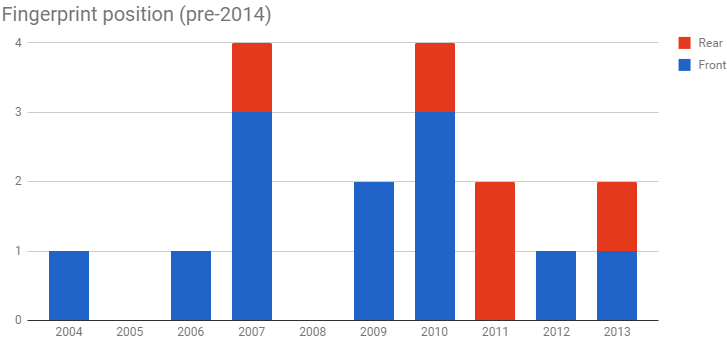Counterclockwise: the fingerprint reader goes back, front, back and side to side
Judul Posting : Counterclockwise: the fingerprint reader goes back, front, back and side to side
Link : Counterclockwise: the fingerprint reader goes back, front, back and side to side
The first phone with a fingerprint reader was the Pantech GI100 from 2004. It had a reader at the center of its D-Pad, one of those early readers that required you to swipe your finger across them. This was a flip phone so the distinction between front and back is a bit iffy, but we're calling this one front-mounted (based on when the phone is flipped open).
A few fingerprint readers appeared here and there over the years, but they were extremely rare – most years saw less than 4 phones. It wasn't until 2013 that biometric security became a thing in the public's consciousness.
It was Apple's doing, of course, the company is rarely the first but always has great marketing. The iPhone 5s was one of two phones to have a fingerprint reader that year (front-mounted), the other was the HTC One Max (rear mounted).

Note: the chart counts the number of devices released rather, not their popularity.
The very next year, 2014, there were 33 phones brandishing a reader and the overwhelming majority of them had it on the front (29 vs. 4). But in 2016 the balance shifted to rear-mounted readers.
The Huawei Mate 10 showed that you can have both great screen-to-body ratio and a front-mounted reader, but we think the ergonomics don't quite work out. If the bezel-less trend persists, most readers will be on the back.
Then there are the side-mounted readers. Pushed mostly by Sony but not exclusively – ZTE, Huawei and Nexbit (now owned by Razer) had side-mounted readers in 2015, the same year that Sony launched the Xperia Z5 and co. Still, these are a relative rarity.
There's a good reason for that – just as the screen pushed the fingerprint reader away from the front, it's pushing it off the sides too. A side-mounted reader means thicker bezels and it also limits how thin the phone itself can be. It's all about that coveted bezel-less design once again.
Apple is trying to set a new trend now – no fingerprint reader at all! The iPhone X uses facial 3D scanning instead. That necessitated a notch at the top of the screen, though, and it's not necessarily a good look (though opinions certainly differ).
For completeness sake, here's the fingerprint reader position chart from 2004 to 2014. We split it since the post-2013 boom skewed the combined chart and made it hard to read.

Demikianlah Info postingan berita Counterclockwise: the fingerprint reader goes back, front, back and side to side
Anda sedang membaca posting tentang Counterclockwise: the fingerprint reader goes back, front, back and side to side dan berita ini url permalinknya adalah https://phonten.blogspot.com/2017/11/counterclockwise-fingerprint-reader.html Semoga info lowongan ini bisa bermanfaat.
0 Response to "Counterclockwise: the fingerprint reader goes back, front, back and side to side"
Post a Comment